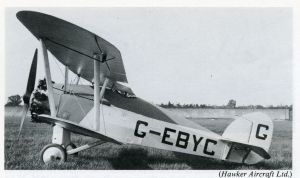From Wikipedia, the free encyclopedia
| Heron
|

|
| Role
|
Biplane fighter
Type of aircraft
|
| National origin
|
United Kingdom
|
| Manufacturer
|
Hawker Aircraft
|
| First flight
|
1925
|
| Status
|
Prototype
|
| Number built
|
1
|
The
Hawker Heron
was the first
fighter aircraft
designed at
Hawker Aircraft
with a basically metal structure.
Sydney Camm
was the chief designer that introduced what became the typical structure for all Hawker aircraft until the introduction of the jet-powered
Hawker P.1040
. This structure consisted of metal tubes (steel or aluminium) with their ends
swaged
so that they could be connected to each other by means of "
fishplates
" and
bolts
(sometimes with
ferrules
to protect the tubes).
Design
[
edit
]
The design was produced in 1924 as a private venture version of the
Hawker Woodcock
fighter with the wooden structure of the Woodcock replaced by a mainly metal structure, but as the design developed, the use of a metal structure resulted in an entirely new aircraft.
[1]
The Heron was a single bay
biplane
with a metal structure as described above and fabric covered. It was powered by a 455 hp (339 kW)
Bristol Jupiter
VI engine driving a two-bladed wooden propeller. (A metal propeller was also flown but showed no improvement of performance). There was provision for two .303 in (7.7 mm)
Vickers machine guns
.
The Air Ministry issued
Specification 25/24
to Hawker for a single-seat high-speed fighter landplane and a prototype was ordered for evaluation.
[2]
The first flight of the prototype,
serial number
J6989
, flown by
P.S.W. Bulman
was made in 1925. Despite being heavier than the similar powered Woodcock, it was 15 mph (24 km/h) faster and was praised by the pilots that flew it for its excellent handling properties.
[3]
Due to little interest from the
Air Ministry
, only one aircraft was built and it was returned to Hawker after testing.
Specifications
[
edit
]
Data from
Hawker Aircraft since 1919
[4]
General characteristics
- Crew:
1
- Length:
22 ft 3 in (6.78 m)
- Wingspan:
31 ft 10 in (9.70 m)
- Height:
9 ft 9 in (2.97 m)
- Wing area:
291 sq ft (27.0 m
2
)
- Empty weight:
2,120 lb (962 kg)
- Gross weight:
3,126 lb (1,418 kg)
- Fuel capacity:
60 imp gal (72 US gal; 270 L)
- Powerplant:
1 ×
Bristol Jupiter
VI
radial engine
, 455 hp (339 kW)
- Propellers:
2-bladed Watts wooden propeller
Performance
- Maximum speed:
156 mph (251 km/h, 136 kn) at 9,800 ft (3,000 m)
- Endurance:
3 hr 30 min
- Service ceiling:
23,200 ft (7,100 m)
- Time to altitude:
5 min 30 s to 10,000 ft (3,000 m)
Armament
See also
[
edit
]
Related development
References
[
edit
]
- Fozzard, John W., ed. (1991).
Sydney Camm & the Hurricane
. Shrewsbury, UK: Airlife.
ISBN
1-85310-270-9
.
- Mason, Francis K. (1991).
Hawker Aircraft since 1920
. London: Putnam.
ISBN
0-85177-839-9
.
- Meekcoms, K. J.; Morgan, E. B. (1994).
The British Aircraft Specification File
. Tonbridge, Kent, UK:
Air-Britain
.
ISBN
0-85130-220-3
.
External links
[
edit
]